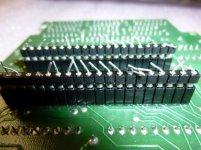jharre
Experienced Member
The ad said this Mod I Expansion Interface had an extra "memory board" when I bought it. Turns out it was a Tandy double-density adapter that should have been mounted in the socket for the WD1771. Unfortunately, it popped free during shipping and apparently bounced around quite a bit. All the pins got rather messed up as you can see in the picture.
Thought I could carefully straighten out the pins, but they are quite brittle and the first few broke right off even though I was very gentle.
The real solution seems to be to unsolder these and replace them, but I've looked around and can't seem to find the interconnect devices they used. They are pretty tall to make sure the board clears parts mounted to the EI board.
Does anyone know of a source for these - hopefully with a part number or part name?

Thought I could carefully straighten out the pins, but they are quite brittle and the first few broke right off even though I was very gentle.
The real solution seems to be to unsolder these and replace them, but I've looked around and can't seem to find the interconnect devices they used. They are pretty tall to make sure the board clears parts mounted to the EI board.
Does anyone know of a source for these - hopefully with a part number or part name?



